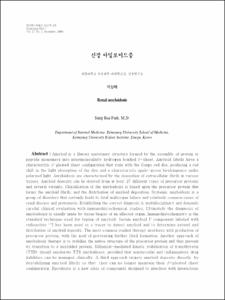신장 아밀로이드증
- Keimyung Author(s)
- Park, Sung Bae
- Journal Title
- Keimyung Medical Journal
- Issued Date
- 2008
- Volume
- 27
- Issue
- 2
- Keyword
- Amyloidosis; Eprodisate; Proteinuria
- Abstract
- Amyloid is a fibrous quaternary structure formed by the assembly of protein or peptide monomers into intermolecularly hydrogen bonded β-sheet. Amyloid fibrils have a characteristic β-pleated sheet configuration that stain with the Congo red dye, producing a red shift in the light absorption of the dye and a characteristic apple-green birefringence under polarized light. Amyloidosis are characterized by the deposition of extracellular fibrils in various
tissues. Amyloid deposits can be derived from at least 27 different types of precursor proteins
and several variants. Classification of the amyloidosis is based upon the precursor protein that
forms the amyloid fibrils, and the distribution of amyloid deposition. Systemic amyloidosis is a
group of disorders that certainly leads to fatal multiorgan failure and relatively common cause of
renal disease and proteinuria. Establishing the correct diagnosis is multidisciplinary and demands
careful clinical evaluation with immunohistochemical studies. Ultimately the diagnosis of amyloidoisis is usually made by tissue biopsy of an affected organ. Immunohistochemistry is the standard technique used for typing of amyloid. Serum amyloid P component labeled with radioactive 123I has been used as a tracer to detect amyloid and to determine extend and
distribution of amyloid deposits. The most common studied therapy interferes with production of
precursor protein, with the goal of preventing further fibril formation. Another approach of
amyloidosis therapy is to stabilize the native structure of the precursor protein and thus prevent
its transition to a misfolded protein. Diflunisal-mediated kinetic stabilization of transthyretin
(TTR) should ameliorate TTR amyloidoses, provided that nonsteroidal anti-inflammatory drug
liabilities can be managed clinically. A third approach targets amyloid deposits directly, by
destabilizing amyloid fibrils so that they can no longer maintain their β-pleated sheet
configuration. Eprodisate is a new class of compounds designed to interfere with interactions between amyloidogenic proteins and glycosaminoglycans. Eprodisate binds to glycosaminoglycanbinding sites on the amyloid fibrils and thereby causing regression of amyloidosis. Targeting amyloid formation directly is a new direction that offers hope to patients with serious organ dysfunction. Although the management of amyloidosis has been frustrating, specific anti-amyloid drugs will become available in the near future.
- Alternative Title
- Renal amyloidosis
- Keimyung Author(s)(Kor)
- 박성배
- Publisher
- Keimyung University School of Medicine
- Citation
- 박성배. (2008). 신장 아밀로이드증. Keimyung Medical Journal, 27(2), 79–93.
- Type
- Article
Items in Repository are protected by copyright, with all rights reserved, unless otherwise indicated.
